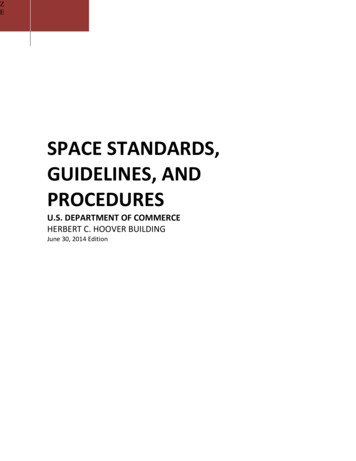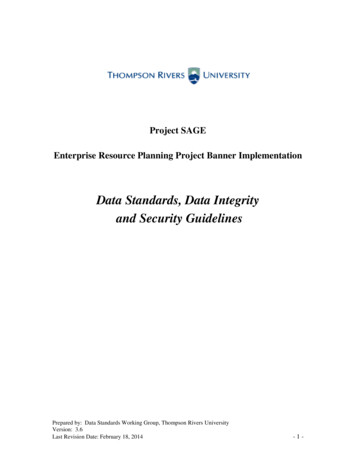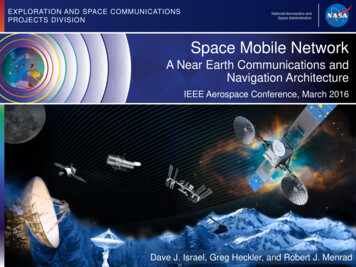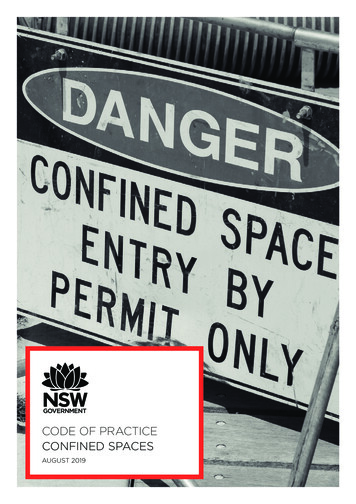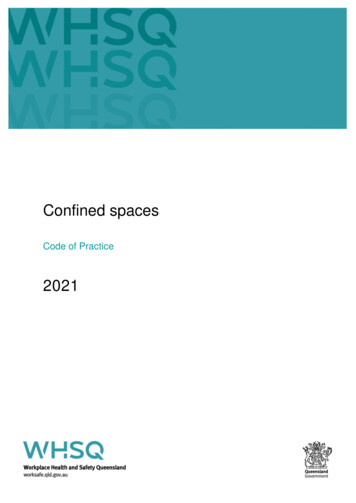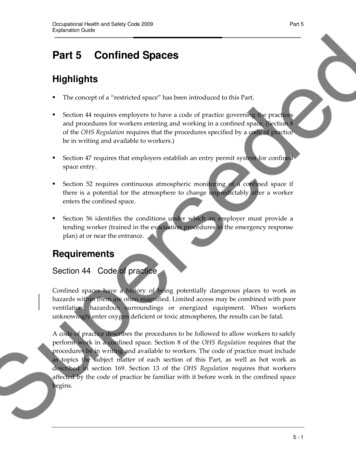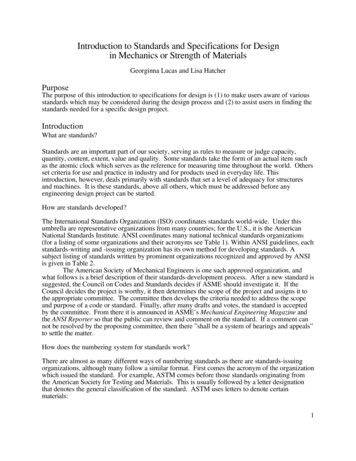
Transcription
Office SpaceStandards and GuidelinesRevised: February, 2003
ContentsIntroduction .3Principles.3Definitions .4Space Allocation Standards .6Purpose .6Space Envelope.6Special Purpose Space.6Space Estimate Example.7Authorities .7Implementation .8Reporting .8Office Design Guidelines.8Purpose .8Support Spaces .10General Guidelines .11Project Management Services .12Appendix “A” - Sample Workstation Space LayoutsAppendix “B” - Sample Meeting Room LayoutsOffice Space Standards and GuidelinesContents
IntroductionThese new and revised “GNWT Office Space Standards and Guidelines”1, will be usedwhen planning and designing space used by Government of the Northwest Territoriesdepartments, boards and agencies in general office accommodation owned and leasedby the GNWT.The space allocation standards, which were approved by the Financial ManagementBoard2, and the office design guidelines recognize the GNWT’s need to stay currentwith trends and best practices in space management and provide functional workenvironments for its employees.PrinciplesThe standards and guidelines incorporate the following key principles:Departments should be empowered to plan their office space. This principlerecognizes that, if office space is treated as an administrative resource and managersare given the opportunity to plan office space using simplified standards and guidelines,more creative, cost-effective solutions to satisfying office space needs will result.Standards and guidelines should be simplified. This principle recognizes thatsimplified, minimum standards and broad guidelines written in non-technical languagewill enable departments to plan their own office.Space should be allocated according to functional requirements. This principlerecognizes that the simply allocating office space to people based on their position orrank in an organizational hierarchy rather than the functional needs of their work mayresult in a less productive workplace and additional costs.Space should be flexible. This principle recognizes that fewer barriers to change, lessdisruption when change does occur, and lower costs in money and time can beaccomplished by: using open space planning whenever practical reducing the number of different sizes of spaces standardizing the sizes of as many spaces as possible1These standards and guidelines replace former standards titled “GNWT Office Space AllocationStandards”, approved by the Financial Management Board under FB-93-03-7(d).2Approved by the FMB under FB-98-08-10.Office Space Standards and Guidelines3
DefinitionsCirculation Space - Spaces, such as corridors and aisles, provided within an office toallow for access to various work areas.Enclosed Workstation - A workstation with four-sided, floor-to-ceiling enclosures usingdrywall, demountable or removable partitions.Department - The GNWT department, board or agency requiring office space.Full-Time Equivalent (FTE) - A measure of labor utilization which approximates thenumber of persons employed by a department and requiring office space. Office spaceplanning is based on the anticipated number of FTEs at the mid-point of an occupancyor a five year period, whichever is less.Functional Program - A detailed statement describing what is needed by a departmentto perform its activities efficiently, safely and comfortably. It includes a descriptionabout the occupant group’s requirements for each workstation, support, circulation andspecial purpose spaces, based upon the approved space standards and guidelines . Italso describes how the areas relate to each other functionally and may describe thetype and size of furniture and equipment that needs to be accommodated. A functionalprogram is used by a designer to complete a space layout.General Office Space - Office space used to accommodate general administrativefunctions (workstation, support, and circulation space) and does not require specialdesign and construction because of other special program delivery activities. Generaloffice space can usually be reallocated between departments with minimal changesrequired.Guidelines -Statements designed to provide direction when planning office space.While not mandatory, guidelines should be followed unless there is good reason not todo so.Office Project - A leasing and/or construction project for provision of office space for adepartment. Office projects may be approved as part of a general office plan or on anad hoc basis as a result of department requests.Open Workstation - A workstation with no enclosures or two to three enclosures belowceiling height using screens or panels.Space Envelope - The total amount of general purpose office space provided to adepartment, as determined under these standards.Office Space Standards and Guidelines4
Special Purpose Space - Additional, non-standard areas required by a department toaccommodate specific activities which are unique and essential to delivery of thedepartment’s particular program. For example, laboratories, health units or clinics,courtrooms, hearing rooms, staffed libraries, mainframe computer rooms, workshops,central mail operations rooms, radio/communications centers, survey and mappingrooms, public assembly areas, exhibit areas, conference or training complexes, centralstorage/warehousing areas, trade shops, etc. Special purpose space is not included inthe space envelope allocation determined under these standards.Standards - A set of prescribed maximum space allocations which must be followedwhen planning office space. Standards do not establish or imply minimum spaceentitlement and consideration should be given by departments to meet theirrequirements using less space.Support Space - Shared space containing furniture, equipment or materials used by adepartment. For example, photocopier rooms, file cabinets, meeting rooms, coffeecounters, etc. These shared spaces are located near the people that use them on aregular basis and may be enclosed or open depending on the type of equipment andthe work performed in them.Tenant Improvements -The interior of an office building, designed and constructed tothe meet the requirements of the department. This includes partitions, screens, finishes,signs and modifications to telephone, lighting, electrical, heating and ventilation asnecessary to service the office layout. The term ‘fit up’ is sometimes used to describethe construction of tenant improvements.Useable Space - The space that is actually useable by a department. It does notinclude accessory areas such as washrooms, janitor closets, electrical and telephoneclosets, public corridors and elevator lobbies. Corridors within the boundaries of adepartment’s space are included in the useable space.Workstation Space - Spaces provided to people to accommodate their individualfurniture and equipment and allow them to perform their job functions. Workstationspace may be enclosed or open depending on the confidentiality, security, visual andacoustical privacy requirements of the job.Office Space Standards and Guidelines5
Space Allocation StandardsPurposeThese standards describe the allocation of office space to Government of the NorthwestTerritories departments, boards and agencies. The standards do not establish or implyminimum space entitlement and departments are encouraged to consider ways ofmeeting their requirements using less space.Space EnvelopeThe space envelope for a department will be calculated using the following allocations:Standard Space Envelope AllocationsUseable Space per FTEFTEsm2ft2First 522.9246Next 518.1195Remaining17.2185Special Purpose SpaceIn addition to general purpose space which is accommodated within the spaceenvelope, most departments will require special purpose space. This space is notincluded in the space envelope calculation.Special purpose space requirements must be determined through a functional programand justified based on an inventory of the furniture, equipment, supplies and materialsto be accommodated.If a special purpose space will contain a workstation (e.g., librarian, lab technician), theposition allocated the workstation will not be included in the FTE count used to calculatethe department’s space envelope.Office Space Standards and Guidelines6
Space Estimate ExampleAssuming a department requires office space for 50 FTEs and has justified arequirement for 56 square meters of special purpose space, the estimated spacerequirement would be calculated as follows:Number of FTEs(A)Space Allocation per FTE(B)m2ft2Space Allocation(A) x 688.07,400893.09,60556.0600949.010,205Space Envelope:Plus Special Purpose Space:Total Estimated Space Requirement:AuthoritiesThe Deputy Minister of the Department shall certify to the Deputy Minister of PublicWorks and Services that the FTEs for which office space is requested and the specialpurpose space that is requested are bona fide requirements of the Department.Where the request can be accommodated within the existing funded office spaceinventory and the fit up can be funded by the Department, the Deputy Minister of PublicWorks and Services has the authority to proceed with the project.Where additional funding is required for lease or fit up of space, the Minister of PublicWorks and Services and the Minister of the Department, will jointly submit a request tothe Financial Management Board.The Deputy Minister of the Department shall approve the functional program and thedesign of tenant improvements for the office space.Office Space Standards and Guidelines7
ImplementationThe Department of Public Works and Services shall provide project managementservices for the design and construction of tenant improvements in all buildings underits care and custody. In addition, it will provide project management services for officespace in other buildings when requested by the Department.A functional program must be completed for each project to verify space requirementsand confirm project costs.The Office Space Guidelines, shall provide guidance to the Department of Public Worksand Services and the Department on the cost effective design of the tenantimprovements.ReportingThe Department of Public Works and Services shall submit a report in the first quarter ofeach fiscal year, to the Financial Management Board which lists the inventory andallocation of office space as of the preceding March 31. The report will list: the Department the office building the number of FTEs, as certified by the Deputy Minister of the Department the allocation of general office space, as per the standard the allocation of special purpose space, as certified by the Deputy Minister of theDepartment the actual space occupiedOffice Design GuidelinesPurposeThe following guidelines will provide direction when designing office space. Althoughadherence to the guidelines is not mandatory, they serve as a reference for soundmanagement decisions and should be followed unless there are justified reasons fordeviations.Office Space Standards and Guidelines8
Workstation Spaces3The following is a list of recommended workstation sizes for various job functions. Usingthese workstation sizes will promote efficient space planning within building grids andprovide flexibility for accommodating future organizational changes.Space AllocationSpaceTypeFunctional Assignmentm2ft2EnclosedType AFrequent meetings with up to four others and/orrequiring confidentiality, security, visual andacoustical privacy. Typical assignment for DeputyMinister or equivalent.22.5240EnclosedType BFrequent meetings with up to two others and/orrequiring confidentiality, security, visual andacoustical privacy. Typical assignment for AssistantDeputy Minister, Director, senior position in chargeof a regional or district office or equivalent.13.9150EnclosedType CFrequent meetings with up to two others and/orrequiring confidentiality, security, visual andacoustical privacy. Typical assignment for positioninvolved with counseling, human resourcesmanagement or other sensitive situations requiringongoing visual and acoustical privacy.9.3100OpenType DConcentrated multi-source paperwork: compilinginformation, reading, writing, analyzing, calculatingand referencing multiple sources of material; allowsfor manual and automated drafting functions. Typicalassignment for managerial, professional or technicalstaff.9.3100OpenType EMulti-task paper intensive work: telephone work,keyboarding, filing, sorting documents, handlingmail, editing, operating equipment, scheduling,receiving visitors. Typical assignment for secretaryand administrative support staff.6.570OpenType FSpecific, task-oriented work, focusing on data inputinto electronic media. Typical assignment for clericaland data-entry staff.4.5503Appendix “A” of these Office Space Standards and Guidelines contains illustrations of workstationlayouts with compatible furniture dimensions.Office Space Standards and Guidelines9
Support SpacesThe following is a list of recommended space planning allowances for office supportfunctions.Typical Space Allocation andFunctional AssignmentSupport SpaceFiling CabinetAllow 1.0 m2 (11 ft2) per filing cabinet.Plan CabinetsAllow 1.5 m2 (15 ft2) per plan storage cabinet.Storage Shelf Units,Storage RoomsAllow up to 1 m2 (10 ft2) per shelving unit either free-standing orwithin storage rooms.Photocopier AreaAllow 5 m2 (50 ft2) for standard photocopying requirements toinclude paper storage and work surface.General Work AreaAllow up to 5 m2 (50 ft2) for common/shared workstation forfunctions such as mail sorting, computer equipment, facsimilemachine, etc.Reference Library Local Area Network (LAN)Computer RoomSpace allocation determined on a case by case basis taking intoaccount equipment footprint and other functional requirements.First Aid RoomFirst Aid Room will be provided based on regulations under theSafety Act. For buildings with multiple departments, space for FirstAid Room will be allocated based on number of FTEs in eachdepartment.Reception AreaSpace allocation based on functional needs; e.g., visitor/customertraffic, security requirements, reception activities, etc.Quiet RoomsAllow 1 Quiet Room of 9.3 m2 (100 ft2) for every 10 openworkstations.Meeting Rooms4 Coffee Counter/NookAllow 1 counter/nook of 1.16 m2 (12.5 ft2): per 30-FTE department; or per floor, where departments each have less than 30 FTEs.Allow up to 1 m2 (10 ft2) per shelving unit.Allow 5 m2 (50 ft2) per reading and work tableMeetings of 4 to 5 people allow 11.15 m2 (120 ft2)Meeting of 6 to 7 people allow 13.90 m2 (150 ft2)Meetings of 12 people allow 22.30 m2 (240 ft2)4Appendix “B” of these Office Space Standards and Guidelines contains illustrations of meetingroom layouts.Office Space Standards and Guidelines10
General GuidelinesThe following space planning and design guidelines are recommended: In order to create flexibility, promote air quality, increase natural light penetration andreduce costs, attempt to limit the number of enclosed workstations to 45% of thetotal workstations on a floor. Enclosed workstations may be provided to senior managers (e.g., director level andabove) and positions which conduct continuous (e.g., on a daily basis for at least 3to 4 hours during the day) confidential meetings. The supervision of staff and/oroccasional confidential meetings is not usually considered sufficient cause for anenclosed workstation. The provision of meeting rooms and shared Quiet Rooms is amore efficient and functional solution. Enclosed offices should be positioned on the building core and provided with glazingto receive natural light. Screens should be 1.65m (65") or lower in height. Allocate approximately 25% of the space as circulation space. For periodic large group (12 or more people) meetings, conference rooms should berented from the private sector rather than accommodated in general office space.However, if private conference facilities are not available locally, departments canprovide for conference-size rooms by connecting adjoining meeting rooms withceiling height, soundproof, moveable partitions. Departments should consider collocating in order to share support spaces andequipment and reduce costs. Plan space so that short term space requirements are isolated from longer termrequirements to enable future space reductions. To promote open workstation planning, Quiet Rooms can be provided for smallgroup meetings and work requiring privacy. To provide maximum functionality asshared workstations, Quiet Rooms should be equipped with furniture, computerequipment and communications connections. To create flexibility, apply a modular approach to planning; i.e., plan spaces whichare compatible with building grids. Most existing facilities are built on a 5' x 5' grid. Plan the size of smaller support spaces so that they can be interchangeable withworkstations for people.Office Space Standards and Guidelines11
Attempt to standardize workstation furniture so that, when moves occur, only peopleneed to move.Project Management ServicesThe Department of Public Works and Services is responsible for providing projectmanagement services for the design and construction of tenant improvements in alloffice buildings under its care and custody. In addition, it will provide projectmanagement services for office space in other buildings when requested by theDepartment. A list of PWS regional contacts to obtain project management services isprovided below.PWS Regional ContactsRegionContactFort SmithRegional SuperintendentTel: (867) 872-7260Fax: (867) 872-2830North SlaveRegional SuperintendentTel: (867) 873-7650Fax: (867) 873-0257InuvikRegional SuperintendentTel: (867) 979-7140Fax: (867) 979-3463Office Space Standards and Guidelines12
Workstation Space Type F - Open, 4.5 m2 (50 ft2)Office Space Standards and GuidelinesAppendix “A”
Workstation Space Type E - Open, 6.5 m2 (70 ft2)Office Space Standards and GuidelinesAppendix “A”
Workstation Space Type D - Open, 9.3 m2 (100 ft2)Office Space Standards and GuidelinesAppendix “A”
Workstation Space Type C - Closed, 9.3 m2 (100 ft2)Office Space Standards and GuidelinesAppendix “A”
Workstation Space Type B - Closed, 13.9 m2 (150 ft2)Office Space Standards and GuidelinesAppendix “A”
Workstation Space Type A - Closed, 22.5 m2 (240 ft2)Office Space Standards and GuidelinesAppendix “A”
Meeting Room - 4 to 5 people, 11.15 m2 (120 ft2)Office Space Standards and GuidelinesAppendix “B”
Meeting Room - 6 to 7 people, 13.9 m2 (150 ft2)Office Space Standards and GuidelinesAppendix “B”
Meeting Rooms - 8 to 12 people, 17.8 m2 (192 ft2) & 22.3 m2 (240 ft2)Office Space Standards and GuidelinesAppendix “B”
Office Space Standards and Guidelines 4 Definitions Circulation Space - Spaces, such as corridors and aisles, provided within an office to allow for access to various work areas. Enclosed Workstation - A workstation with four-sided, floor-to-ceiling enclo
